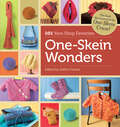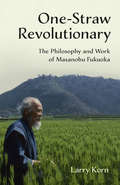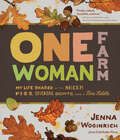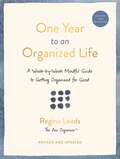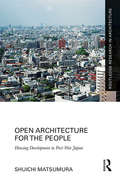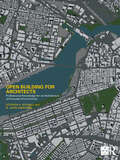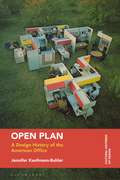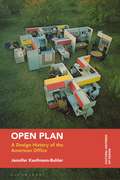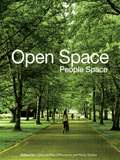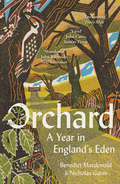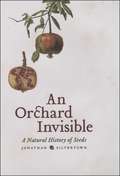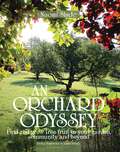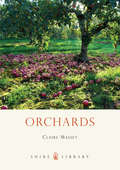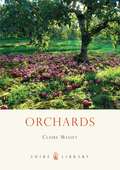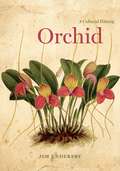- Table View
- List View
One-Skein Wonders®: A World Of Possibilities Inspired By Just One Skein (One-Skein Wonders)
by Judith DurantIf you&’re like most knitters, you have lonely skeins of yarn in your closet — casualties of projects discarded mid-row or leftovers from long-completed pieces. Offering 101 charming designs that use just a single skein of yarn, Judith Durant shows you how to turn these extra bits of fiber into stylish hats, mittens, scarves, and tea cozies. Covering a wide range of tastes and styles, this collection will inspire you to dig out your orphan yarn and get stitching.
One-Straw Revolutionary: The Philosophy and Work of Masanobu Fukuoka
by Larry KornOne-Straw Revolutionary represents the first commentary on the work of the late Japanese farmer and philosopher Masanobu Fukuoka (1913 – 2008), widely considered to be natural farming’s most influential practitioner. Mr. Fukuoka is perhaps most known for his bestselling book The One-Straw Revolution (1978), a manifesto on the importance of no-till agriculture, which was at the time of publication a radical challenge to the global systems that supply the world’s food, and still inspires readers today. Larry Korn, who apprenticed with Mr. Fukuoka in Japan at the time, translated the manuscript and brought it to the United States, knowing it would change the conversation about food forever. The One-Straw Revolution, edited by Korn and Wendell Berry, was an immediate international success, and established Mr. Fukuoka as a leading voice in the fight against conventional industrial agriculture. In this new book, through his own personal narrative, Larry Korn distills his experience of more than thirty-five years of study with Mr. Fukuoka, living and working on his farm on Shikoku Island, and traveling with Mr. Fukuoka to the United States on two six-week visits. One-Straw Revolutionary is the first book to look deeply at natural farming and intimately discuss the philosophy and work of Mr. Fukuoka. In addition to giving his personal thoughts about natural farming, Korn broadens the discussion by pointing out natural farming’s kinship with the ways of indigenous cultures and traditional Japanese farming. At the same time, he clearly distinguishes natural farming from other forms of agriculture, including scientific and organic agriculture and permaculture. Korn also clarifies commonly held misconceptions about natural farming in ways Western readers can readily understand. And he explains how natural farming can be used practically in areas other than agriculture, including personal growth and development. The book follows the author on his travels from one back-to-the-land commune to another in the countryside of 1970s Japan, a journey that eventually led him to Mr. Fukuoka’s natural farm. Korn’s description of his time there, as well as traveling with Mr. Fukuoka during his visits to the United States, offers a rare, inside look at Mr. Fukuoka’s life. Readers will delight in this personal insight into one of the world’s leading agricultural thinkers.
One-Woman Farm: My Life Shared with Sheep, Pigs, Chickens, Goats, and a Fine Fiddle
by Jenna WoginrichPopular blogger and first-time farmer Jenna Woginrich shares the spirit and experiences of living close to the land at Cold Antler Farm.
One Year to an Organized Life: From Your Closets to Your Finances, the Week-by-Week Guide to Getting Completely Organized for Good
by Regina LeedsFrom the professional named "Best Organizer in Los Angeles," a comprehensive, week-by-week bible to completely streamline all aspects of your life-from your closets to your finances.Who would you be if you felt at peace and had more time and money? An organized life enables you to have more freedom, less aggravation, better health, and to get more done. For nearly twenty years, Regina Leeds has helped even the messiest turn their lives around. One Year to an Organized Life is a unique week-by-week approach that you can begin at any time of year. Regina helps you break down tasks and build routines over time so that life becomes simple, not overwhelming. Whether you're living in chaos or just looking for new ways to simplify, this essential book will help you get the whole household organized-and stay that way.
One Year to an Organized Life: A Week-by-Week Mindful Guide to Getting Organized for Good
by Regina LeedsA comprehensive, week-by-week bible to completely streamline all aspects of your life—now revised & updated for a global pandemic world of working from home and learning to de-stress while you de-clutter. Who would you be if you felt at peace and had more time and money? An organized life enables you to have more freedom, less aggravation, better health, and to get more done. Regina Leeds has helped even the messiest turn their lives around. One Year to an Organized Life is a unique week-by-week approach that you can begin at any time of year. Regina helps you break down tasks and build routines over time so that life becomes simple, not overwhelming. Whether you're living in chaos or just looking for new ways to simplify, this essential book will help you get the whole household organized-and stay that way. Covid has shaken humanity to the core and forced us to slow down and reimagine the way we use our living spaces. In a flash, the space we knew simply as home was suddenly a classroom, our office and the gym. And, at a time when stress and anxiety is at an all-time high, it no longer seems odd to meditate. It feels life-saving. If life is to be re-imagined, shouldn&’t we also do that with our living spaces? In this revised and updated edition of One Year to an Organized Life, Regina Leeds reveals how to optimize your space—for work, family and daily calmness (with plenty of new affirmations and reward systems built into her organizing tips).
Onion (large print)
by RnibThis image shows yellow onion, part of the Allium family, which includes leeks, garlic and chives.There is a locator dot shown, which will be at the top left of the page when the image is the correct way up. The plans thin roots are at the bottom of the page. Up the page from the roots is the oval-shaped, onion bulb, covered in a thin, papery, light-brown skin.Growing out of the top of the bulb are five leaves that go up the page vertically. They are long, hollow and pointed at the top of the image. The leaves are pale at the bottom and green further up the page. The onion is a monocot plant. It has a flower head on a long stem that consists of many individual small flowers arranged in a ball shape. They have not been shown in this image. There are many varieties of onion varying in sweetness, strength of flavour, size and colour.
Onion (UEB contracted)
by RnibThis image shows yellow onion, part of the Allium family, which includes leeks, garlic and chives.There is a locator dot shown, which will be at the top left of the page when the image is the correct way up. The plans thin roots are at the bottom of the page. Up the page from the roots is the oval-shaped, onion bulb, covered in a thin, papery, light-brown skin.Growing out of the top of the bulb are five leaves that go up the page vertically. They are long, hollow and pointed at the top of the image. The leaves are pale at the bottom and green further up the page. The onion is a monocot plant. It has a flower head on a long stem that consists of many individual small flowers arranged in a ball shape. They have not been shown in this image. There are many varieties of onion varying in sweetness, strength of flavour, size and colour.
Onion (UEB uncontracted)
by RnibThis image shows yellow onion, part of the Allium family, which includes leeks, garlic and chives.There is a locator dot shown, which will be at the top left of the page when the image is the correct way up. The plans thin roots are at the bottom of the page. Up the page from the roots is the oval-shaped, onion bulb, covered in a thin, papery, light-brown skin.Growing out of the top of the bulb are five leaves that go up the page vertically. They are long, hollow and pointed at the top of the image. The leaves are pale at the bottom and green further up the page. The onion is a monocot plant. It has a flower head on a long stem that consists of many individual small flowers arranged in a ball shape. They have not been shown in this image. There are many varieties of onion varying in sweetness, strength of flavour, size and colour.
Open Architecture for the People: Housing Development in Post-War Japan (Routledge Research in Architecture)
by Shuichi MatsumuraOpen Architecture for the People explores Japanese architecture and the three different phases of development between the years 1950 and 2018. Changing ways of life through differing generations have caused fluctuations in the building industry. This book demonstrates how each generation's expectations have resulted in discernible eras in architecture which can be examined collectively as well as in isolation. For example, the sudden increase in productivity from 1950 brought about by the Industrial Revolution flowed to the production of buildings and homes and designs were influenced by modern ideas. With over thirty black and white images to illustrate the changes, Matsumura brings to light architectural developments that have previously been confined to Japanese speaking academics. In doing so, the book broadens the scope for further architectural examinations internationally. It would be ideal for academics, students and professionals within the areas of architecture and urban planning, particularly those with an interest in Japanese architecture.
Open Architecture for the People: Housing Development in Post-War Japan (Routledge Research in Architecture)
by Shuichi MatsumuraOpen Architecture for the People explores Japanese architecture and the three different phases of development between the years 1950 and 2018. Changing ways of life through differing generations have caused fluctuations in the building industry. This book demonstrates how each generation's expectations have resulted in discernible eras in architecture which can be examined collectively as well as in isolation. For example, the sudden increase in productivity from 1950 brought about by the Industrial Revolution flowed to the production of buildings and homes and designs were influenced by modern ideas. With over thirty black and white images to illustrate the changes, Matsumura brings to light architectural developments that have previously been confined to Japanese speaking academics. In doing so, the book broadens the scope for further architectural examinations internationally. It would be ideal for academics, students and professionals within the areas of architecture and urban planning, particularly those with an interest in Japanese architecture.
Open Building for Architects: Professional Knowledge for an Architecture of Everyday Environment (Open Building)
by Stephen H. Kendall N. John HabrakenOpen Building is an internationally recognized approach to the design of buildings and building complexes with roots in the way the ordinary built environment grows and regenerates. The Open Building approach recognizes that both stability and change are realities to be managed in the contemporary built environment. Buildings – and the neighborhoods they occupy – are not static during the most stable times or during times of rapid social and technical change. They are living organisms that need constant adjustments to remain attractive, safe and valuable.Using case studies of built projects from around the world, this book explains the Open Building approach and discusses important characteristics of everyday built environment that the Open Building approach designs for. It also presents a key method that can be used to put the approach into use. It addresses questions such as: How can we design large projects for inevitable change? How can we balance the demands of large projects for efficient implementation with the need for ‘fine-grained’ decision-making control? How can we separate design tasks, one task being the design of what should last a century, the other task being the design of more mutable units of occupancy? How can we identify and share architectural themes and, at the same time, make variations on them? How can we use the Open Building approach to steward the earth’s scarce resources and contribute to a circular economy that benefits all people? This book is an essential resource for practitioners, investors and developers, regulators, builders, product manufacturers and educators interested in why the Open Building approach matters and how to practice Open Building.
Open Building for Architects: Professional Knowledge for an Architecture of Everyday Environment (Open Building)
by Stephen H. Kendall N. John HabrakenOpen Building is an internationally recognized approach to the design of buildings and building complexes with roots in the way the ordinary built environment grows and regenerates. The Open Building approach recognizes that both stability and change are realities to be managed in the contemporary built environment. Buildings – and the neighborhoods they occupy – are not static during the most stable times or during times of rapid social and technical change. They are living organisms that need constant adjustments to remain attractive, safe and valuable.Using case studies of built projects from around the world, this book explains the Open Building approach and discusses important characteristics of everyday built environment that the Open Building approach designs for. It also presents a key method that can be used to put the approach into use. It addresses questions such as: How can we design large projects for inevitable change? How can we balance the demands of large projects for efficient implementation with the need for ‘fine-grained’ decision-making control? How can we separate design tasks, one task being the design of what should last a century, the other task being the design of more mutable units of occupancy? How can we identify and share architectural themes and, at the same time, make variations on them? How can we use the Open Building approach to steward the earth’s scarce resources and contribute to a circular economy that benefits all people? This book is an essential resource for practitioners, investors and developers, regulators, builders, product manufacturers and educators interested in why the Open Building approach matters and how to practice Open Building.
Open Plan: A Design History of the American Office (Cultural Histories of Design)
by Jennifer Kaufmann-BuhlerOriginally inspired by a progressive vision of a working environment without walls or hierarchies, the open plan office has since come to be associated with some of the most dehumanizing and alienating aspects of the modern office. Author Jennifer Kaufmann-Buhler traces the history and evolution of the American open plan from the brightly-colored office landscapes of the 1960s and 1970s to the monochromatic cubicles of the 1980s and 1990s, analyzing it both as a design concept promoted by architects, designers, and furniture manufacturers, and as a real work space inhabited by organizations and used by workers.The thematically structured chapters each focus on an attribute of the open plan to highlight the ideals embedded in the original design concept and the numerous technical, material, spatial, and social problems that emerged as it became a mainstream office design widely used in public and private organizations across the United States. Kaufmann-Buhler's fascinating new book weaves together a variety of voices, perspectives, and examples to capture the tensions embedded in the open plan concept and to unravel the assumptions, expectations, and inequities at its core.
Open Plan: A Design History of the American Office (Cultural Histories of Design)
by Jennifer Kaufmann-BuhlerOriginally inspired by a progressive vision of a working environment without walls or hierarchies, the open plan office has since come to be associated with some of the most dehumanizing and alienating aspects of the modern office. Author Jennifer Kaufmann-Buhler traces the history and evolution of the American open plan from the brightly-colored office landscapes of the 1960s and 1970s to the monochromatic cubicles of the 1980s and 1990s, analyzing it both as a design concept promoted by architects, designers, and furniture manufacturers, and as a real work space inhabited by organizations and used by workers.The thematically structured chapters each focus on an attribute of the open plan to highlight the ideals embedded in the original design concept and the numerous technical, material, spatial, and social problems that emerged as it became a mainstream office design widely used in public and private organizations across the United States. Kaufmann-Buhler's fascinating new book weaves together a variety of voices, perspectives, and examples to capture the tensions embedded in the open plan concept and to unravel the assumptions, expectations, and inequities at its core.
Open Space: Open Space: People Space 2
by Catharine Ward Thompson Penny TravlouHighly visual and containing contributions from leading names in landscape, architecture and design, this volume provides a rare insight into people’s engagement with the outdoor environment; looking at the ways in which the design of spaces and places meets people’s needs and desires in the twenty-first century. Embracing issues of social inclusion, recreation, and environmental quality, the editors explore innovative ways to develop an understanding of how the landscape, urban or rural, can contribute to health and quality of life. Open Space: People Space examines the nature and value of people’s access to outdoor environments. Led by Edinburgh’s OPENspace research centre, the debate focuses on current research to support good design for open space and brings expertise from a range of disciplines to look at: an analysis of policy and planning issues and challenges understanding the nature and experience of exclusion the development of evidence-based inclusive design innovative research approaches which focus on people’s access to open space and the implications of that experience. Invaluable to policy makers, researchers, urban designers, landscape architects, planners, managers and students, it is also essential reading for those working in child development, health care and community development.
Open Space: People Space
by Catharine Ward Thompson Penny TravlouHighly visual and containing contributions from leading names in landscape, architecture and design, this volume provides a rare insight into people’s engagement with the outdoor environment; looking at the ways in which the design of spaces and places meets people’s needs and desires in the twenty-first century. Embracing issues of social inclusion, recreation, and environmental quality, the editors explore innovative ways to develop an understanding of how the landscape, urban or rural, can contribute to health and quality of life. Open Space: People Space examines the nature and value of people’s access to outdoor environments. Led by Edinburgh’s OPENspace research centre, the debate focuses on current research to support good design for open space and brings expertise from a range of disciplines to look at: an analysis of policy and planning issues and challenges understanding the nature and experience of exclusion the development of evidence-based inclusive design innovative research approaches which focus on people’s access to open space and the implications of that experience. Invaluable to policy makers, researchers, urban designers, landscape architects, planners, managers and students, it is also essential reading for those working in child development, health care and community development.
Orchard: A Year In England's Eden
by Benedict Macdonald Nicholas GatesSpend a year in an orchard, celebrating its imperilled, overlooked abundance of life. England's ancient orchards, collaborations between people and nature, are sources of hope for the future. Protecting them promises a far richer England for the centuries to come, for wildlife and for us.
An Orchard Invisible: A Natural History of Seeds
by Jonathan SilvertownThe story of seeds, in a nutshell, is a tale of evolution. From the tiny sesame that we sprinkle on our bagels to the forty-five-pound double coconut borne by the coco de mer tree, seeds are a perpetual reminder of the complexity and diversity of life on earth. With An Orchard Invisible, Jonathan Silvertown presents the oft-ignored seed with the natural history it deserves, one nearly as varied and surprising as the earth’s flora itself. Beginning with the evolution of the first seed plant from fernlike ancestors more than 360 million years ago, Silvertown carries his tale through epochs and around the globe. In a clear and engaging style, he delves into the science of seeds: How and why do some lie dormant for years on end? How did seeds evolve? The wide variety of uses that humans have developed for seeds of all sorts also receives a fascinating look, studded with examples, including foods, oils, perfumes, and pharmaceuticals. An able guide with an eye for the unusual, Silvertown is happy to take readers on unexpected—but always interesting—tangents, from Lyme disease to human color vision to the Salem witch trials. But he never lets us forget that the driving force behind the story of seeds—its theme, even—is evolution, with its irrepressible habit of stumbling upon new solutions to the challenges of life. "I have great faith in a seed," Thoreau wrote. "Convince me that you have a seed there, and I am prepared to expect wonders." Written with a scientist’s knowledge and a gardener’s delight, An Orchard Invisible offers those wonders in a package that will be irresistible to science buffs and green thumbs alike.
An Orchard Invisible: A Natural History of Seeds
by Jonathan SilvertownThe story of seeds, in a nutshell, is a tale of evolution. From the tiny sesame that we sprinkle on our bagels to the forty-five-pound double coconut borne by the coco de mer tree, seeds are a perpetual reminder of the complexity and diversity of life on earth. With An Orchard Invisible, Jonathan Silvertown presents the oft-ignored seed with the natural history it deserves, one nearly as varied and surprising as the earth’s flora itself. Beginning with the evolution of the first seed plant from fernlike ancestors more than 360 million years ago, Silvertown carries his tale through epochs and around the globe. In a clear and engaging style, he delves into the science of seeds: How and why do some lie dormant for years on end? How did seeds evolve? The wide variety of uses that humans have developed for seeds of all sorts also receives a fascinating look, studded with examples, including foods, oils, perfumes, and pharmaceuticals. An able guide with an eye for the unusual, Silvertown is happy to take readers on unexpected—but always interesting—tangents, from Lyme disease to human color vision to the Salem witch trials. But he never lets us forget that the driving force behind the story of seeds—its theme, even—is evolution, with its irrepressible habit of stumbling upon new solutions to the challenges of life. "I have great faith in a seed," Thoreau wrote. "Convince me that you have a seed there, and I am prepared to expect wonders." Written with a scientist’s knowledge and a gardener’s delight, An Orchard Invisible offers those wonders in a package that will be irresistible to science buffs and green thumbs alike.
An Orchard Invisible: A Natural History of Seeds
by Jonathan SilvertownThe story of seeds, in a nutshell, is a tale of evolution. From the tiny sesame that we sprinkle on our bagels to the forty-five-pound double coconut borne by the coco de mer tree, seeds are a perpetual reminder of the complexity and diversity of life on earth. With An Orchard Invisible, Jonathan Silvertown presents the oft-ignored seed with the natural history it deserves, one nearly as varied and surprising as the earth’s flora itself. Beginning with the evolution of the first seed plant from fernlike ancestors more than 360 million years ago, Silvertown carries his tale through epochs and around the globe. In a clear and engaging style, he delves into the science of seeds: How and why do some lie dormant for years on end? How did seeds evolve? The wide variety of uses that humans have developed for seeds of all sorts also receives a fascinating look, studded with examples, including foods, oils, perfumes, and pharmaceuticals. An able guide with an eye for the unusual, Silvertown is happy to take readers on unexpected—but always interesting—tangents, from Lyme disease to human color vision to the Salem witch trials. But he never lets us forget that the driving force behind the story of seeds—its theme, even—is evolution, with its irrepressible habit of stumbling upon new solutions to the challenges of life. "I have great faith in a seed," Thoreau wrote. "Convince me that you have a seed there, and I am prepared to expect wonders." Written with a scientist’s knowledge and a gardener’s delight, An Orchard Invisible offers those wonders in a package that will be irresistible to science buffs and green thumbs alike.
An Orchard Invisible: A Natural History of Seeds
by Jonathan SilvertownThe story of seeds, in a nutshell, is a tale of evolution. From the tiny sesame that we sprinkle on our bagels to the forty-five-pound double coconut borne by the coco de mer tree, seeds are a perpetual reminder of the complexity and diversity of life on earth. With An Orchard Invisible, Jonathan Silvertown presents the oft-ignored seed with the natural history it deserves, one nearly as varied and surprising as the earth’s flora itself. Beginning with the evolution of the first seed plant from fernlike ancestors more than 360 million years ago, Silvertown carries his tale through epochs and around the globe. In a clear and engaging style, he delves into the science of seeds: How and why do some lie dormant for years on end? How did seeds evolve? The wide variety of uses that humans have developed for seeds of all sorts also receives a fascinating look, studded with examples, including foods, oils, perfumes, and pharmaceuticals. An able guide with an eye for the unusual, Silvertown is happy to take readers on unexpected—but always interesting—tangents, from Lyme disease to human color vision to the Salem witch trials. But he never lets us forget that the driving force behind the story of seeds—its theme, even—is evolution, with its irrepressible habit of stumbling upon new solutions to the challenges of life. "I have great faith in a seed," Thoreau wrote. "Convince me that you have a seed there, and I am prepared to expect wonders." Written with a scientist’s knowledge and a gardener’s delight, An Orchard Invisible offers those wonders in a package that will be irresistible to science buffs and green thumbs alike.
An Orchard Odyssey: Finding and growing tree fruit in your garden, community and beyond
by Naomi SladeInspiring and practical, this is a lovely resource for anyone looking to grow fruit trees or start an orchard, whether in your garden or as a community project.For centuries, orchards have been a compelling and important part of our landscape. The sight of a fruit tree, blushing in blossom in the spring, and then laden with fresh fruit in the summer and autumn, can be truly enchanting, inspiring folklore and art. Not only do orchards provide bountiful fruit for families and communities, they are also attractive to pollinators such as bees, and make a wonderful habitat for birds.There are many ways of incorporating orchard living into your lifestyle, no matter how busy or short of space you are. Written by esteemed horticulturalist Naomi Slade, this gloriously illustrated resource illuminates the possibilities and enables you to make it a reality – whether you have a few fruit trees already or have always wanted an orchard of your own.An Orchard Odyssey shows you how to plant and care for your trees and suggests fruit trees suitable for different spaces. It also covers the benefits of orchard for conservation and biodiversity, orchard heritage, and the role of fruit trees in garden and landscape design. The guide promotes the 'five trees' principle of orchards, and encourages the reader to embrace the orchards in a way that is personal to them. Packed with practical ideas and inspiration, let this delightful book encourage you to re-engage with tree fruit in new ways: look at it the right way and everyone can have an orchard.
Orchards (Shire Library #632)
by Claire MassetSome of Britain's surviving orchards are almost six hundred years old, and whether laden with summer fruit or stripped bare by the winter are places of great beauty. Throughout history, they have played an important role in life both rural and urban, providing not just food and drink but also a haven for wildlife and a setting for age-old customs and social gatherings. But when did orchards first appear? What is wassailing and who did it? Why has England lost almost two-thirds of its orchards since 1950 – and what is being done about it today? This beautifully illustrated book reveals the engaging story and rich diversity of Britain's apple, pear and cherry orchards.
Orchards (Shire Library #632)
by Claire MassetSome of Britain's surviving orchards are almost six hundred years old, and whether laden with summer fruit or stripped bare by the winter are places of great beauty. Throughout history, they have played an important role in life both rural and urban, providing not just food and drink but also a haven for wildlife and a setting for age-old customs and social gatherings. But when did orchards first appear? What is wassailing and who did it? Why has England lost almost two-thirds of its orchards since 1950 – and what is being done about it today? This beautifully illustrated book reveals the engaging story and rich diversity of Britain's apple, pear and cherry orchards.
Orchid: A Cultural History
by Jim EndersbyAt once delicate, exotic, and elegant, orchids are beloved for their singular, instantly recognizable beauty. Found in nearly every climate, the many species of orchid have carried symbolic weight in countless cultures over time. The ancient Greeks associated them with fertility and thought that parents who ingested orchid root tubers could control the sex of their child. During the Victorian era, orchids became deeply associated with romance and seduction. And in twentieth-century hard-boiled detective stories, they transformed into symbols of decadence, secrecy, and cunning. What is it about the orchid that has enthralled the imagination for so many centuries? And why do they still provoke so much wonder? Following the stories of orchids throughout history, Jim Endersby divides our attraction to them into four key themes: science, empire, sex, and death. When it comes to empire, for instance, orchids are a prime example of the exotic riches sought by Europeans as they shaped their plans for colonization. He also reveals how Charles Darwin’s theory of evolution became intimately entangled with the story of the orchid as he investigated their methods of cross-pollination. As he shows, orchids—perhaps because of their extraordinarily diverse colors, shapes, and sizes—have also bloomed repeatedly in films, novels, plays, and poems, from Shakespeare to science fiction, from thrillers to elaborate modernist novels. Featuring many gorgeous illustrations from the collection of the Royal Botanic Gardens, Kew, Orchid: A Cultural History tells, for the first time, the extraordinary story of orchids and our prolific interest in them. It is an enchanting tale not only for gardeners and plant collectors, but anyone curious about the flower’s obsessive hold on the imagination in history, cinema, literature, and more.
